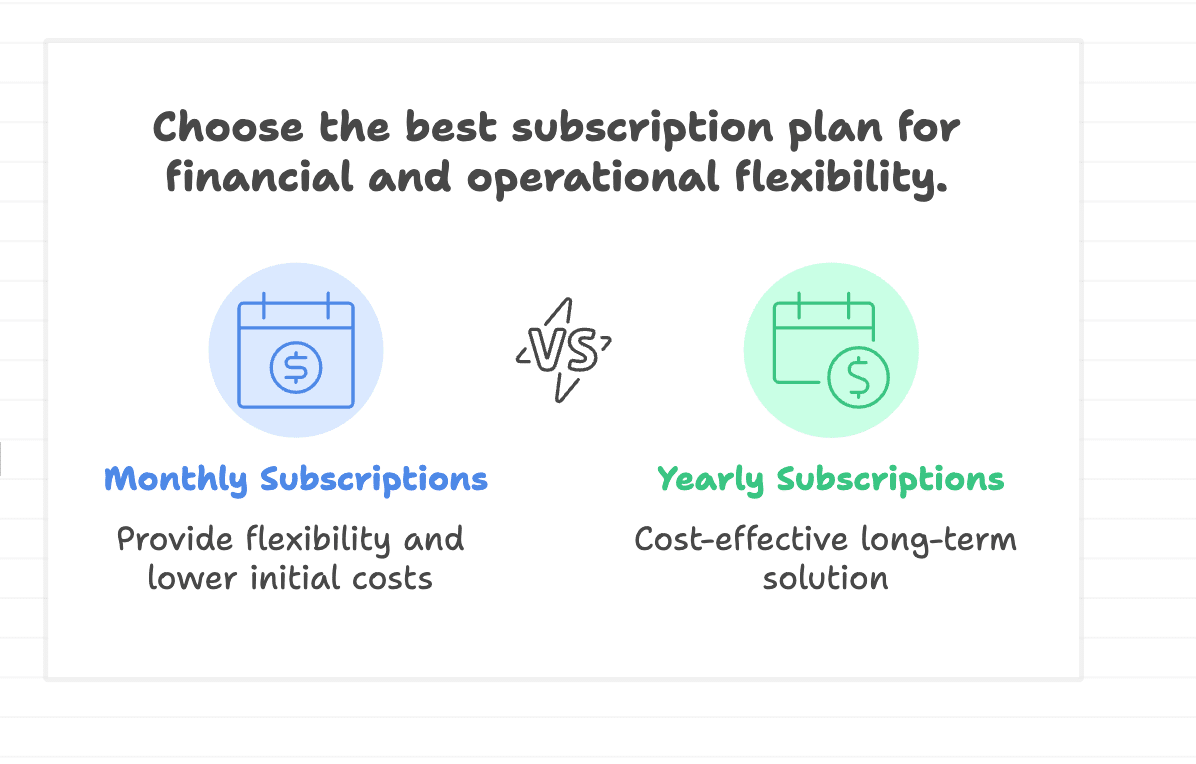When it comes to Learning Management Systems (LMS), selecting the pricing structure can affect a company’s financial plan and overall satisfaction with the system in place. Comparing the merits of monthly versus annual subscriptions requires considering factors that play a crucial role in saving money over time and enhancing user satisfaction. This guide aims to delve into the advantages and disadvantages of each option to assist individuals in making informed choices.
The Versatility of Subscription Plans
Subscriptions, on a monthly basis, provide flexibility for businesses to tailor their plans according to changing requirements and financial limitations they may face over time. This can be particularly beneficial for companies going through rapid expansion or dealing with fluctuating levels of users. Moreover, the relatively lower initial expenses tied to monthly payments can help manage cash flow effectively, especially for startups or small businesses. When considering pricing models, Blackbaud pricing is a key factor to examine, as it offers scalable solutions that can accommodate the diverse needs of growing organizations.
However, this adaptability typically comes with a price tag attached. Monthly subscriptions generally end up costing more in the long term compared to yearly plans. Individuals contemplating this route need to balance the advantages of flexibility with the potential for increased expenses over time.
The Economic Benefits of Membership
Yearly subscriptions may involve a lump-sum payment but typically come with significant discounts that are very appealing to businesses with consistent customer numbers and predictable growth trends in mind. Opting for an annual duration can help companies enjoy reduced expenses and ultimately lead to considerable cost savings in the long run.
In addition, annual subscriptions frequently offer benefits like improved customer service or the ability to use premium features. These additional features can enhance the user experience by offering more value than just saving money alone. However, companies need to evaluate their future requirements thoughtfully because opting for a yearly subscription may limit flexibility when situations change.
Planning Your Budget: Predicting Expenses
Both pricing structures have varying effects on budgeting strategies. Monthly subscriptions offer flexibility in planning and can adapt to unforeseen adjustments without causing substantial financial burdens. This level of predictability is ideal for companies that place importance on term adaptability.
Alternatively, yearly subscriptions offer a view of extended expenditure. Having a predictable expense aids in better budgeting accuracy and reduces unexpected financial burdens. This predictability may attract businesses prioritizing foresight and sustained well-being.
Effects on User Interaction
Subscription models can have an impact on user engagement as well. Opting for monthly plans could stimulate involvement since users continuously assess the value they receive. Regular payments help users remember the service and encourage them to maximize their investment potential.
Choosing a subscription plan could help build bonds and loyalty with the service provider as users feel assured of long-term access to the platform, which may boost their involvement significantly over time. However, the lack of prompts might cause some users to become less active, resulting in the need for measures to sustain user engagement levels.
Assessing the Requirements of the Organization
Selecting the pricing strategy entails assessing the requirements of the organization by examining trends in user growth, financial constraints, and overarching objectives to inform decision-making processes effectively. For individuals who value adaptability and instant cash flow as a priority, a monthly subscription arrangement may align better with their needs. On the contrary, entities with stable user numbers and a focus on long-term strategizing could potentially benefit from opting for annual subscription plans instead.
It’s important to evaluate the characteristics and advantages provided by each LMS provider when making a decision. Certain platforms might provide rewards for long-term commitments that could sway the decision toward longer-term contracts.
Conclusion
In the end, choosing between monthly and yearly LMS subscriptions depends on the organization’s priorities and financial plans. Monthly options offer flexibility and quick adjustments in the short term, whereas annual subscriptions offer cost-effectiveness and stability in the long run. Organizations can make a decision by evaluating their requirements and selecting the pricing strategy that best fits their objectives to achieve financial benefits and enhance user satisfaction.








































